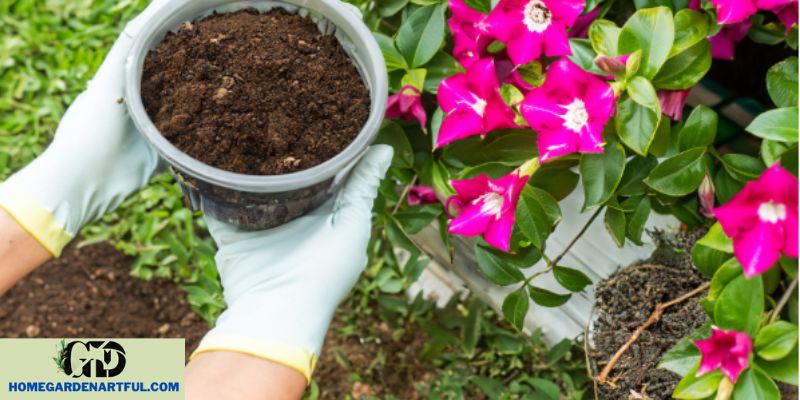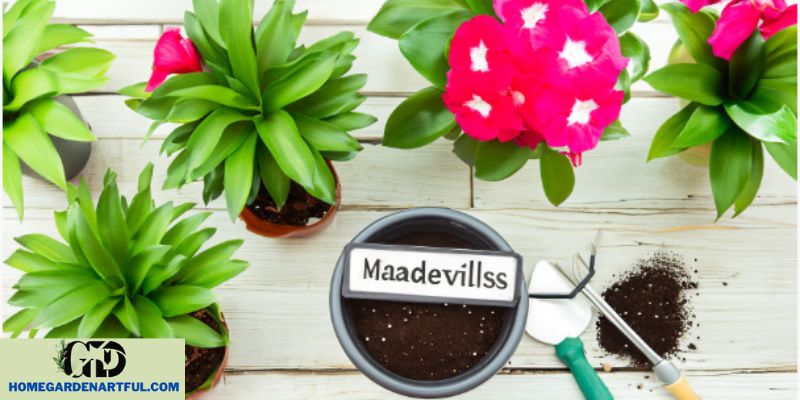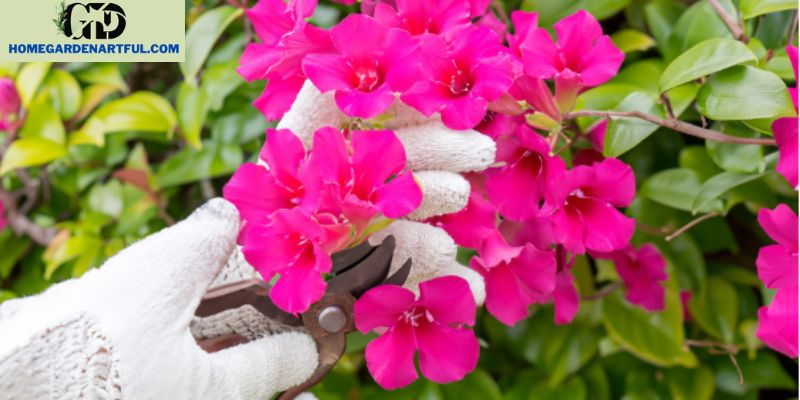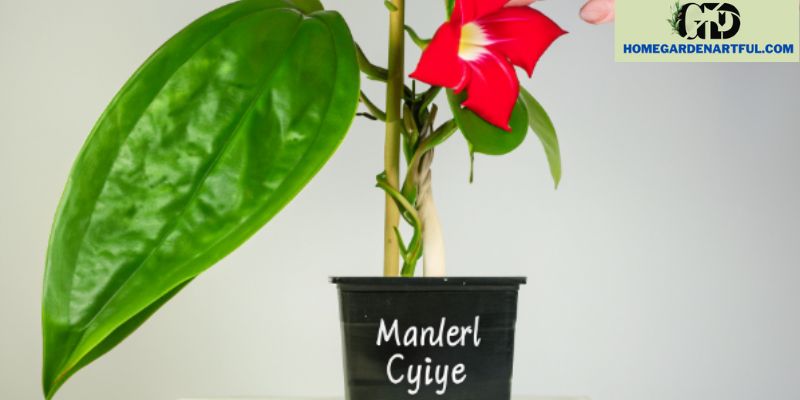Mandevilla plants are a popular choice for gardeners due to their beautiful flowers and vining habits. However, proper care is essential to keep these tropical plants healthy and blooming. In this article, we will guide you through the necessary steps to master the care of a mandevilla plant.
One of the most critical factors in caring for a mandevilla is providing the right soil, water, and sunlight conditions. It’s also essential to fertilize them correctly and prevent and manage any pests or common issues that may arise. Finally, we will cover maintenance tips and pruning techniques to ensure lasting growth and beauty for your mandevilla plant.
Key Takeaways:
- Mandevilla plants require specific soil, water, and sunlight conditions to thrive.
- Proper fertilization is vital for healthy foliage and vibrant flowers.
- Pests and common issues such as aphids and whiteflies can be prevented and managed through organic methods.
- Maintenance, including pruning and trellising, is essential for long-lasting growth and beauty.
Choosing the Right Soil and Planting Mandevillas

Mandevilla plants, such as the popular pink mandevilla and the mandevilla amazon, are tropical perennial plants that require specific growing conditions to thrive. One of the most critical factors for healthy mandevilla growth is the soil in which it is planted.
The ideal soil for mandevillas is a well-draining potting mix that allows proper root development and water absorption. Root rot from standing water is a common problem with mandevillas, so it is crucial to ensure proper drainage.
When planting mandevillas, it is essential to ensure that the root ball is level with the top of the soil. Avoid planting the mandevilla too deeply, as this can lead to root suffocation and poor growth.
For optimal growth, mandevillas should be planted in a tropical plant environment that provides plenty of warmth and humidity throughout the year.
Providing Optimal Sunlight and Temperature Conditions
When it comes to vining mandevillas, proper sunlight and temperature conditions are crucial for their growth, habit, and flowering. These tropical plants thrive in warm climates and require full sun to produce their iconic blooms.
If you live in a tropical climate, you can plant your mandevilla in a spot that receives direct sunlight for six to eight hours a day. However, if you live in a more temperate climate, it is best to provide your mandevilla with partial shade during the hottest parts of the day.
Temperature is also an essential factor to consider when caring for your mandevilla. These plants prefer warm temperatures between 60-80°F, and anything below 50°F can be detrimental to their growth and health. If you live in a cooler climate, it’s best to grow your mandevilla in a container so that you can bring it indoors during colder temperatures.
It’s also important to note that mandevillas are climbers, so providing support such as trellises or stakes will help them grow properly and avoid sprawling. By providing the right amount of sunlight and temperature, you’ll be able to enjoy the beautiful foliage and vibrant flowers of your vining mandevilla for years to come.
Fertilizing Strategies for Healthy Mandevillas

As a perennial plant, mandevillas require regular fertilization to ensure proper growth and maintain their vibrant foliage and flowers. Understanding the nutrient needs of mandevillas and utilizing the right fertilizer is vital for their overall health and vitality.
Mandevilla Fertilizer Needs: Mandevillas require a balanced fertilizer with equal nitrogen, phosphorus, and potassium (N-P-K) ratios. They also need other nutrients like iron, zinc, manganese, magnesium, and calcium for optimal growth.
Organic Compost: Organic compost is the best source of fertilizer for mandevillas. It enhances soil fertility and promotes beneficial microbial activity, which translates to better root development and overall plant health. Be sure to use compost that is well-aged and screened to remove any contaminants.
| Type of Soil | Ideal Soil pH |
|---|---|
| Alkaline Soil | 6.5 to 7.5 |
| Neutral Soil | 6.0 to 7.0 |
Soil pH: The ideal soil pH for mandevillas ranges from 6.0 to 7.5. Ensure that your soil pH falls within this range. If you have alkaline soil, it is essential to add soil acidifiers such as sulfur or iron sulfate to adjust the pH levels.
Fertilizing Technique: Fertilize mandevillas every two to three weeks during the growing season, reducing the frequency during the dormant state. Avoid applying fertilizer directly to plant foliage or stems as this can cause plant burn. Additionally, do not fertilize when the soil is dry, and water plants well before and after fertilization.
By following these fertilizing strategies, you can ensure that your mandevilla plants thrive with healthy foliage and vibrant flowers.
Managing Pests and Common Issues
While mandevilla plants are generally hardy and disease-resistant, they can be susceptible to certain pests and issues. Gardeners should be aware of these common problems and take preventative measures to keep their plants healthy and thriving.
Mandevilla Pests
One of the most common pests that can afflict mandevilla plants are aphids, tiny insects that feed on the sap of the plant and can cause wilting and stunted growth. Another common pest is the whitefly, which feeds on the underside of leaves and can cause yellowing and premature leaf drop. Both pests can be combated through the use of insecticidal soap, which is a safe and effective organic solution for controlling pests without harming the plant.
Greenhouse Cultivation
Mandevilla plants that are cultivated in greenhouses can be particularly vulnerable to pests and diseases due to the close proximity of plants and the controlled environment. Gardeners should take extra care to maintain proper air circulation and humidity levels in the greenhouse, and regularly monitor their plants for signs of pests and diseases.
Climbing Plants
Because mandevilla plants are climbers, they can be prone to tangling and becoming overgrown. Regular pruning and training can help keep the plant in check and prevent issues such as stem breakage and fungal diseases.
Overall, with proper care and attention, mandevilla plants can provide gardeners with beautiful foliage and striking flowers year after year.
Pruning and Maintenance Tips for Mandevillas

Regular pruning is essential for maintaining the shape and health of mandevilla plants. Pruning encourages new growth, removes dead or damaged foliage, and can help control the size of the plant.
Mandevillas can be pruned at any time of the year, but the best time is during the dormant state, which occurs in winter. When pruning, use sharp, clean shears and make clean cuts just above a set of leaves.
Evergreen mandevillas require less pruning than deciduous varieties. With evergreens, only remove a few inches of growth each year to avoid stress on the plant.
Trellising is also beneficial for mandevillas, as it helps to support the vining habit of the plant. Secure the plant to the trellis with garden ties or twine, being careful not to damage the stems or foliage.
In addition to pruning and trellising, mandevillas can be propagated through stem cuttings. Take a cutting from a healthy plant in the spring or summer, and remove the lower leaves. Dip the cut end in rooting hormone and plant in well-draining soil.
In summary, regular pruning, trellising, and propagation through stem cuttings are all important maintenance techniques for mandevilla plants. By following these tips, gardeners can ensure healthy, vibrant growth and long-term success with their mandevillas.
Conclusion
Proper care is essential for the healthy growth and vibrant blooms of mandevilla plants. By following the guidelines for soil selection, watering, sunlight, and temperature, you can create an optimal environment for your plant to thrive. Remember the importance of regular fertilization and pruning for healthy foliage and growth.
If pests such as aphids or whiteflies occur, take action immediately with organic methods such as insecticidal soap to prevent damage to your plant. In addition, supporting vining mandevillas with trellising can help to promote strong growth and prevent damage to surrounding structures.
Following these care tips for your mandevilla plant will ensure long-term success and enjoyment of this beautiful tropical perennial. Whether you have a pink mandevilla or a mandevilla amazon, the proper care will ensure a lush and beautiful display of flowers for seasons to come.
FAQ
Q: What kind of soil is best for mandevilla plants?
A: Mandevilla plants prefer well-draining soil that is enriched with organic compost.
Q: How often should I water my mandevilla plant?
A: Water your mandevilla plant regularly, ensuring that the soil is evenly moist but not waterlogged. Allow the top inch of soil to dry out before watering again.
Q: How much sunlight do mandevilla plants need?
A: Mandevilla plants thrive in full sunlight, so it is recommended to provide them with at least 6 hours of direct sunlight per day.
Q: What temperatures do mandevilla plants prefer?
A: Mandevilla plants prefer temperatures between 60 and 90 degrees Fahrenheit (15 to 32 degrees Celsius). They are tropical plants and may require protection or brought indoors during colder temperatures.
Q: How often should I fertilize my mandevilla plant?
A: Fertilize your mandevilla plant with a balanced, slow-release fertilizer every 4 to 6 weeks during the growing season to promote healthy foliage and vibrant flowers.
Q: What are some common pests that affect mandevilla plants?
A: Common pests that can affect mandevilla plants include aphids and whiteflies. Regular monitoring and the use of organic insecticidal soap can help manage these pests.
Q: When should I prune my mandevilla plant?
A: Prune your mandevilla plant in early spring before new growth begins or in late winter while it is in a dormant state. Remove dead or damaged branches and shape the plant as desired.


